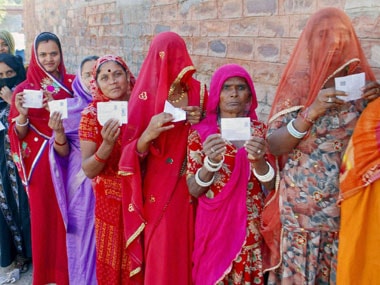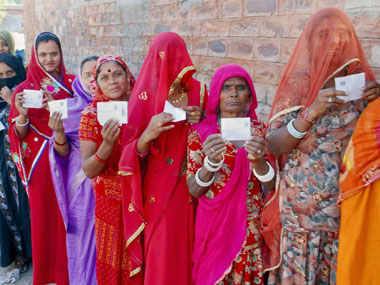What is common between Rajasthan, Madhya Pradesh and Chhattisgarh? All three states recorded more than 70 percent polling in the recent Assembly elections. And the reason could be Narendra Modi. There are two ways to look at the record-breaking polling in these three states. One is rooted in traditional wisdom, the other in Gujarat’s recent history. Chhattisgarh and MP have BJP governments. Rajasthan is ruled by Ashok Gehlot’s Congress. If a high voter turnout is an indicator of the anti-incumbency mood, it can be presumed that all these states have voted for change. That is the traditional way of reading the direction of the wind. [caption id=“attachment_1260755” align=“alignleft” width=“380”]  Women wait to caste their votes in Rajasthan. PTI[/caption] But don’t forget Gujarat. In the last Vidhan Sabha election, the voting percentage in Gujarat was 72.48%. If more voting was automatically equal to a change of government, Modi would have been sitting in the opposition in Gujarat. But Modi not only won the election but also decimated the Congress and Keshubhai Patel. Is a similar script unfolding in Rajasthan, MP and Chhattisgarh? The Gujarat experience shows that had the poll percentage remained unchanged (59.77%), Congress and Keshubhai could have edged ahead of the BJP. Their combined vote would have been more than that of the BJP. But the 24-25 lakh (12%) additional voters swung the election in the BJP’s favour. Most of these additional voters were first-timers, youth and those from the urban middle class. A similar trend was seen in Rajasthan, where polling ended on Sunday. Everywhere, youth and women queued up in large numbers at polling booths. In urban constituencies like Jaipur, Jodhpur and Kota the turnout was nearly 75%, the highest ever in the state’s history. Significantly, it was 7% more than 2008. The figures show 26-27 lakh new voters came out to vote. Who are these voters? The Congress had contested elections in Rajasthan on the basis of its free schemes and doles. If there is any segment that is unlikely to be influenced by freebies like free medicine and free wheat, it has to be the youth and the urban middle class. If youth, first-timers and urban middle class—who want much more than free paracetamol tablets from a government– have come out in large numbers, it can be argued that they didn’t march out to support the Gehlot government. The reason has to be something else. And it begins with M. Modi’s rallies in Rajasthan were packed with youngsters. In every area of Rajasthan, both urban and rural, youngsters occupied the venue and its front rows hours before his arrival. Considering that Rahul Gandhi spoke to vacant chairs or NREGA workers, it is clear who the youth and the urban middle class were favouring. Women, the other category that voted in large number, are unlikely to get influenced by government propaganda either. In a state like Rajasthan, their voting preferences are either influenced by family or by their own experience in the kitchen. Going by anecdotal evidence and surveys, inflation and price-rise were huge factors in the election. If Modi, inflation and an anti-Congress mood are the factors behind the record polling in Rajasthan, BJP is coming back with a huge majority. In the 2008 election the difference between Congress and BJP was just 0.9 percent. If the difference this time goes up disproportionately, Congress could be wiped out. The 75 percent figure has also destroyed the dream of those who were hoping for a hung assembly. This vote in Rajasthan is for a single party and a clear majority. It appears to be a wave in favour of a single man. There are signs emerging for other states too from the trend in Rajasthan. If the combined power of Modi’s persona and anger against the Congress are deciding the election, then the outcome in MP and Chhattisgarh can’t be too different from Rajasthan. If new voters, urban middle class are supporting Modi, it can be argued that the BJP is sweeping the semi-finals 4-0. For the Congress, there is hope only in the argument that voters are rejecting those in power. But that means Congress is losing both Rajasthan and Delhi.
The Congress had contested elections in Rajasthan on the basis of its free schemes and doles. If there is any segment that is unlikely to be influenced by freebies like free medicine and free wheat, it has to be the youth and the urban middle class.
Advertisement
End of Article


)
)
)
)
)
)
)
)
)



